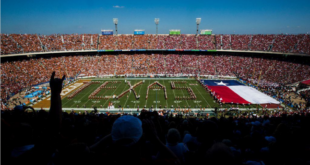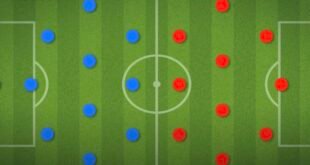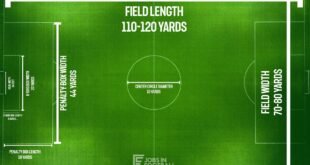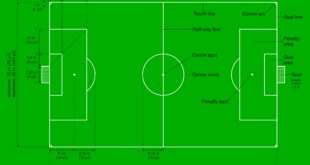A FIFA World Cup soccer field measures between 100 and 110 meters in length and 64 and 75 meters in width. These dimensions set the stage for international play.
Soccer fans and players alike focus on the pitch, where the magic happens during the World Cup. Understanding the field dimensions is crucial, as they define the playing area and influence the game’s dynamics. The pitch’s size, meeting FIFA’s specified range, allows for global variation in play styles.
The length, known as the touchline, and the width, referred to as the goal line, accommodate the strategic depth that different teams bring to the tournament. This rectangular grass canvas is where history is made, skills are showcased, and nations unite over a shared love for the beautiful game. Within these lines, players push their limits, strategies are tested, and the essence of the sport unfolds in every match.
🔴World Cup Soccer Field Dimensions🔴
Table of Contents
The Standard Size Of A World Cup Soccer Field
The Standard Size of a World Cup Soccer Field:
The World Cup is the pinnacle of soccer excellence. Teams compete on fields that match strict size guidelines. These guidelines ensure fair play. The fields are large enough to let players display their best skills. Here, we explore the exact field dimensions that a World Cup soccer field upholds.
Fifa Regulations For Field Dimensions
FIFA sets strict field dimension rules:
- Length: 100 to 110 meters (110 to 120 yards)
- Width: 64 to 75 meters (70 to 80 yards)
- Penalty Area: 16.5 meters (18 yards) from the goal line
- Goal Area: 5.5 meters (6 yards) from the goal line
- Center Circle: 9.15 meters (10 yards) radius
- Corner Arc: 1 meter (1 yard) radius
Variations Across Stadiums
Each stadium can be a little different:
While fields adhere to FIFA’s requirements, they can vary in size. Stadiums may have different sizes. The game stays fair and exciting with these slight differences. The space around the field called the ‘run-off area,’ is also accounted for, ensuring player safety.
| Stadium | Field Length | Field Width |
|---|---|---|
| Luzhniki Stadium | 105 meters | 68 meters |
| Maracanã Stadium | 102 meters | 67 meters |
The fields may vary in dimension, but they are always within FIFA’s acceptable range. The varying field sizes add to the World Cup’s excitement. This ensures teams adapt their strategies and showcase the game’s global appeal. Exploring these dimensions offers fans a deeper appreciation of the World Cup spectacle.
Measuring Up The Field: Length And Width
World Cup Soccer brings together the best teams on a global stage.
Each game plays on a field, or “pitch,” with specific dimensions.
Minimum And Maximum Limits
The soccer field must have a set shape.
Its size has rules set by the authorities.
| Aspect | Minimum | Maximum |
|---|---|---|
| Length | 100 meters (110 yards) | 110 meters (120 yards) |
| Width | 64 meters (70 yards) | 75 meters (80 yards) |
Fields must stick to this size range.
International Differences
Different countries may use slightly different sizes.
FIFA sets the standards for international matches.
- In the USA, fields might be wider.
- In Europe, fields might be longer.
World Cup fields match FIFA’s exact size rules.
Markings On The Pitch
The excitement of a World Cup soccer match isn’t just in the players or the cheers. It lives in the very layout of the field. This layout, marked with precise lines and boxes, tells us a clear story about the rules and flow of the game. Today, we explore these critical markings and what they signify.
The Penalty Area And Goal Box
The penalty area, a must-know zone for every soccer fan, is a big box right in front of the goal. It’s 18 yards long and 44 yards wide. It has a very special line inside it too, the penalty spot. Players take penalty kicks from here, and it’s exactly 12 yards from the goal line. Inside this area lives a smaller box, known as the goal box. Measuring just 6 yards from the goal line, goalkeepers often use this zone to take goal kicks.
The Center Circle And Corner Arcs
Every game starts in the center circle. This circle has a radius of 10 yards from the center mark—perfect for ensuring opposing players keep their distance during kick-offs. Now, look at the corners of the field. Here, you’ll find the corner arcs. These quarter-circles have a radius of 1 yard and show where corner kicks need to be taken from.
These defined markings shape the strategy and the very spirit of the game. They create an invisible structure that players and fans alike rely on, making the soccer pitch more than just a patch of grass—it’s a stage where history is made.
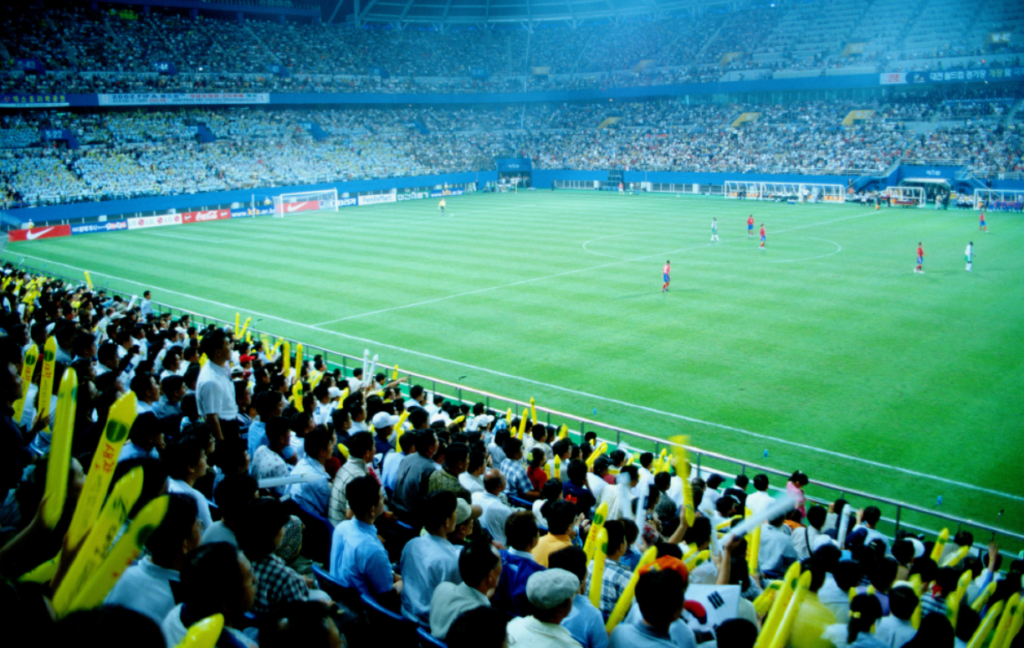
Goal Dimensions: Height And Width Matters
Understanding the specifics of World Cup soccer field dimensions deeply impacts both players and fans alike. A pivotal aspect of these specifications lies in ‘Goal Dimensions: Height and Width Matters’. Striking the perfect balance, these measures ensure fairness and excitement in the beautiful game.
The Importance Of Standardized Goals
Uniform goal dimensions form the cornerstone of international soccer play. These measures provide a level playing field for all teams. They eliminate discrepancies. Teams from around the globe trust these standards. This trust lets them focus on skill and strategy rather than varying goal sizes.
- Height: 8 feet (2.44 meters)
- Width: 8 yards (7.32 meters)
Consistent goal sizes prevent confusion. They also simplify referee decisions and aid in training precision. Both players and coaches benefit from this.
Impact On Gameplay And Strategy
Soccer strategies hinge on goal dimensions. Scores or blocks? It all rests on knowing the goal area. Defenders and attackers model their techniques around these dimensions. A deep understanding of the goal size allows players to fine-tune their shots and defensive moves. Training on standard-sized goals builds confidence.
These regulations also affect the game’s intensity. Spectators feel the thrill of every goal attempt more deeply. This is largely due to the precision required by the players within the established parameters.
Ultimately, dimensions dictate the game’s soul. They foster international unity through a shared set of guidelines, making soccer a universally relatable sport.
Turf Types: Natural Vs Artificial
Understanding Turf Types: Natural vs. Artificial at the World Cup Soccer Field is crucial.
Fans and players alike experience the game differently, depending on the surface.
Learn about the differences here.
Fifa’s Stance On Playing Surfaces
FIFA approves both turf types for World Cup matches.
Natural grass has traditional roots.
Yet, artificial turf is gaining ground due to innovation.
FIFA’s quality program for football turf ensures all surfaces meet rigorous standards.
Pros And Cons Of Each Turf Type
Natural grass offers a classic play.
- Pros:
- Realistic playing experience
- Cooler surface temperature
- Preferred by many athletes
- Cons:
- Requires extensive maintenance
- Weather-dependent quality
- Costlier to upkeep
Artificial grass, also known as synthetic turf, mimics natural grass.
- Pros:
- Consistent play quality
- Durable and long-lasting
- Less affected by weather
- Cons:
- Higher surface temperature
- Requires specific footwear
- Potential for increased injuries
Historical Evolution Of Field Dimensions
The soccer field, or pitch, has not always looked how it does today. Over the years, its dimensions have changed, shaping how the game is played. In soccer’s infancy, fields varied wildly in size with no official regulation. This led to confusion and inconsistency until formal rules emerged. Let’s explore how World Cup soccer field dimensions have evolved throughout history.
Changes In Size Over The Years
Initially, soccer fields had no fixed size. The games took place in whatever space was available. This changed in 1863 when the Football Association set guidelines. The first fields ranged from 100 to 110 yards in length and 50 to 100 yards in width. These dimensions were fine-tuned over time, leading to the standardized sizes we know today. Modern pitches hold firm at 110–120 yards long and 70–80 yards wide, as specified by FIFA.
Here’s a snapshot of how the sizes have shifted:
| Year | Length (yards) | Width (yards) |
|---|---|---|
| 1863 | 100-110 | 50-100 |
| Present | 110-120 | 70-80 |
Influential Tournaments And Their Legacies
Key tournaments have played a role in shaping field dimensions. Notably, the first World Cup in 1930 cemented the idea of universal pitch size, as it became clear that an international standard was crucial for fair play. Meanwhile, memorable World Cups, such as Italy in 1990, pushed for higher-quality pitches. This demand led to FIFA’s strict guidelines on grass quality and field dimensions to improve the game’s competitiveness and safety. These tournaments left their mark by ensuring that pitches met the highest standards, setting the precedent for all future soccer fields.
- 1930: The first World Cup unified pitch size requirements.
- 1990: The Italy World Cup emphasized the importance of pitch quality.
In conclusion, historical adjustments to soccer field dimensions mirror the sport’s growth and the quest for an optimal playing area. From mere patches of land to highly regulated pitches, the journey reflects soccer’s evolution into the world’s beloved game.
The Technical Area: Space For Coaches And Substitutes
The technical area is where soccer’s strategic minds engage in the sport’s most passionate theater. This zone serves as the command center for coaches and their substitutes. From this special area on the sidelines, team strategies unfold and critical decisions take place. Understanding the importance and rules of the technical area enhances appreciation for the game.
Defining The Technical Area
The technical area is designated for a team’s coaching staff and substitutes. It is defined by the rules of soccer and varies slightly between different tournaments.
- Typically extends 1 meter on either side of the designated seating area.
- Runs parallel to the touchline for a distance of 9 to 15 meters.
- Marked by lines or other visible indicators.
Role In Team Management During Matches
During matches, the technical area is a hub of activity. Coaches and substitutes utilize this space to directly affect the game. Key functions include:
- Communication of tactics and instructions to players on the field.
- Observing the match and making strategic adjustments.
- Managing substitutions and tracking team performance.
The presence and behavior of team officials in this area are governed by strict regulations to ensure fair play and order.
Maintaining A World Cup Field
The excitement of the World Cup is not just about the soccer stars and thrilling matches. The field itself plays a critical role in the spectacle. Keeping the pitch in pristine condition is an art as much as a science. As national teams battle for glory, the field must remain perfect. Let’s explore what goes into maintaining a field worthy of the world’s greatest soccer tournament.
Preparation And Upkeep
Preparing a World Cup field is a year-round job. It starts with the right type of grass. Experts choose the grass that can withstand the wear and tear of high-intensity play. Next comes the meticulous process of sowing. Ensuring uniform growth takes precision and care.
- Regular mowing: keeps the grass at an ideal height.
- Watering: balances soil moisture for optimal play.
- Aeration: prevents soil compaction and promotes root growth.
- Fertilization: supplies essential nutrients to the turf.
Daily inspections catch problems early. When necessary, groundskeepers repair patches to keep the surface even.
Challenges Faced By Groundskeepers
Groundskeepers at the World Cup overcame various challenges. Weather patterns cause unexpected issues. Heavy rain can lead to waterlogged turf, while heat stresses the grass. Such conditions demand quick, effective solutions to prevent delays in play.
| Challenge | Groundskeeper’s Solution |
|---|---|
| Persistent Rainfall | Employ drainage systems and sponging techniques. |
| Scorching Heat | Use shade cloths and increase irrigation carefully. |
| Overuse | Rotate areas of play and patch worn spots promptly. |
| Diseases and Pests | Apply eco-friendly fungicides and insecticides. |
Expert groundskeepers adapt to these challenges with skill. Timely responses keep the field game-ready. Despite long hours and unpredictable conditions, their commitment ensures an impeccable pitch for every match.
The Impact Of Field Dimensions On Play Styles
The impact of field dimensions on play styles plays a pivotal role in soccer. Different World Cup stadiums boast unique pitch sizes. This diversity can shape how teams approach the game. Field size can affect strategies, player positions, and the overall tempo of a match.
Adapting Tactics To The Field
Teams must adjust their tactics based on field dimensions. A larger pitch offers more space. This allows teams to use wide attacks. In contrast, a smaller field may favor a more compact defensive style.
- Wide play benefits from expansive fields
- Compact fields pressure opponents into mistakes
Coaches analyze field sizes before matches. They adjust their formations and strategies accordingly. For instance, a team may opt for a 4-3-3 formation on larger fields to exploit the wings. Conversely, on smaller pitches, a 4-4-2 might provide more defensive solidity.
How Dimensions Influence The Game’s Pace
Field dimensions can dictate the pace of the game. Wider and longer fields might lead to a slower-paced game. Teams have more ground to cover, which can tire players out.
- Fast-paced games often occur on smaller fields
- Larger fields can lead to more tactical play
Smaller fields can foster swifter transitions and quick attacks. This is because teams can move the ball from defense to offense rapidly. A team’s fitness levels and speed can be critical factors on larger pitches where there is more space to defend and attack.
Understanding the influence of field dimensions on soccer is essential. Adapting to different fields can be the difference between winning and losing.
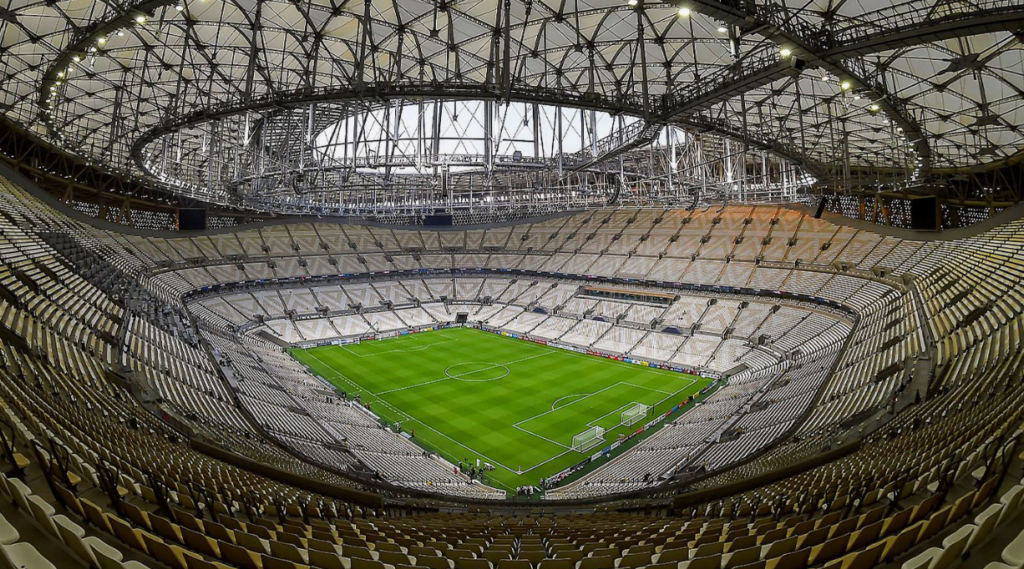
Examples From Iconic Matches
The World Cup brings thrilling soccer matches to life on fields worldwide. Yet, not all pitches are the same size, and these variations can influence the beautiful game in dramatic ways. Let’s dive into some historic matches and dissect how the dimensions of the field played a role in those legendary games.
Memorable Games And Their Fields
- 1970 World Cup Final: Brazil vs. Italy: The Estadio Azteca in Mexico boasted a wide field that allowed Pele and his team to exploit their flair, agility, and precise ball control.
- 1986 World Cup Quarter-Final: Argentina vs. England: Mexico City’s Estadio Azteca again witnessed Maradona’s infamous ‘Hand of God’ goal and his breathtaking ‘Goal of the Century’ on a lush, expansive pitch.
- 1998 World Cup Final: Brazil vs. France: The Stade de France had a large pitch that played into the hands of the French team, aiding Zidane’s mesmerizing dribbles and two head goals.
How Field Dimensions Shaped Outcomes
Field dimensions can subtly guide the fate of a soccer match. Wide fields often enable teams with technical prowess and speed to maneuver around their opponents. On the other hand, narrow pitches may benefit teams with a strong defensive strategy, as there’s less space for attackers to exploit.
| Match | Field Size | Outcome |
|---|---|---|
| 2002 Final: Brazil vs Germany | 68m x 105m | Brazil’s artistry shined on a standard-sized pitch, helping them to secure their fifth title. |
| 2010 Final: Spain vs Netherlands | 68m x 105m | Spain’s tiki-taka style thrived, controlling the match and securing victory with a narrow pitch. |
| 2014 Final: Germany vs Argentina | 68m x 105m | Germany’s tactical discipline was well-suited for the pitch, leading to a late extra-time triumph. |

Frequently Asked Questions On World Cup Soccer Field Dimensions
What are the FIFA World Cup field dimensions?
FIFA standards dictate that a World Cup soccer field must be 100–110 meters long and 64–75 meters wide. These measurements ensure a consistent playing area for high-level international competition.
How does pitch size affect soccer games?
Soccer pitch size impacts player fatigue, strategy, and game dynamics. Larger fields might favor teams with greater stamina and tactical width, while smaller pitches can lead to more direct play and frequent player encounters.
Is there a standard goal size for the World Cup?
Yes, the standard goal size for World Cup matches is 2.44 meters in height and 7.32 meters in width. This uniformity is crucial for goalie training and match consistency across the tournament.
Are all World Cup fields the same size?
Not exactly. World Cup fields can vary within IFAB regulations of 100–110 meters in length and 64–75 meters in width. However, differences are minimal to maintain a standard level of play.
Conclusion
Understanding the specifics of World Cup soccer field dimensions enriches the game experience for fans and players alike. It ensures a standardized, fair playground for the sport’s highest contests. Keep these measurements in mind as you watch teams battle it out on the pitch, where every inch can make a world of difference.
 Cric Enjoy Sports News, Cricket Update, Live Streaming
Cric Enjoy Sports News, Cricket Update, Live Streaming

